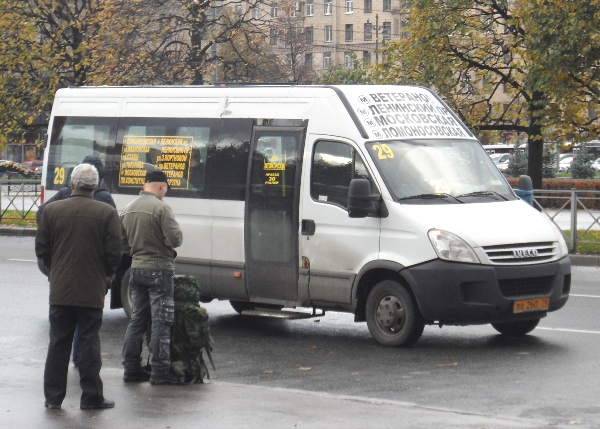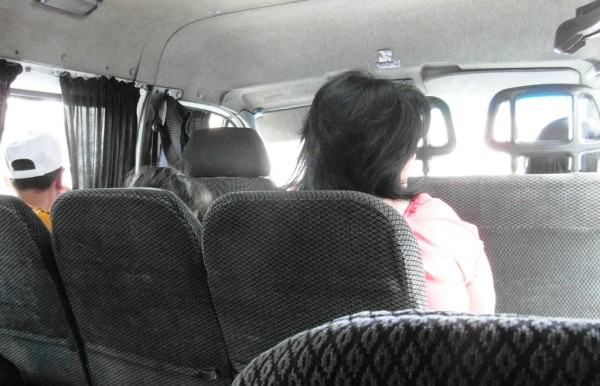
Marshrutka.
In Russian, it means “fixed route.”
In short, it is basically a mini-bus, the age, size and comfort of which may vary greatly. It is also the preferred method of public transportation in much of the former Soviet Union. Whether you are going across town, across the country, or across a border, chances are you will take a marshrutka at some point while traveling in a former Soviet country.
Traveling within a city
Within cities, most marshrutkas follow fixed routes and may or may not have designated stops. You may need to ask someone in advance which marshrutka you need to take as it can be difficult to figure out routes. Alternatively, simply say the name of your destination to the driver and he will likely tell you whether or not he is going that way. Typically, drivers will not stop unless (a) a passenger requests that they stop or (b) they see someone on the road flagging them down. When you reach your destination, call out ostanovka puhzhulsta or ostanavitsa puhzhulsta (stop please).
Marshrutkas are generally pretty inexpensive (the equivalent of 50 cents or less in most cities) and intracity routes are usually a fixed price. If no price is posted in the mini-bus, just ask the driver or a fellow passenger – skolka sto-eet? It is standard to pay the driver when you get off. Some drivers will have a small box in which you can toss your coins or may have an assistant collecting fares for them. Try to pay with exact change if possible.
Be prepared to be squeeze in tightly as there is no limit on how many people can cram into a single marshrutka. You very well may end up hunched over, standing in an aisle.

Between cities
When it comes to intercity routes, marshrutkas will usually leave from a bus station or other easily identifiable location (such as in front of the train station) and will drop you off at the corresponding locale in your destination unless you ask to stop somewhere else along the way. The destination will be marked on a sign in the window, often in Russian, but sometimes in the local language (i.e., Georgian, Armenian, Moldovan) and you will pay the driver in advance or even buy a ticket from a kiosk. In some cities, like Baku, Azerbaijan, the marshrutkas will be lined up at the bus station, clearly organized by destination. In other cities, like Tbilisi, Georgia, they are spread out over a sprawling parking lot with no rhyme or reason. There, your best bet will be to just walk around and tell people your destination – they will point you in the right direction.
While buses may operate on schedules, marshrutkas typically leave when full, even if they technically are “scheduled” to leave at a certain time. For example, when I arrived in Zugdidi, Georgia by overnight train at 7:30 a.m., the driver of a marshrutka bound for Mestia immediately approached me. I hopped in, together with three others. And then we proceeded to wait. And wait and wait and wait. It was another two and a half hours before we finally had enough passengers for the driver to depart. We spent the last hour waiting for just two more.

Similarly, the first time I headed from Tbilisi to Yerevan, drivers told me that the marshrutkas left at 8:00 and 10:00 a.m. I arrived around 7:30 to secure my spot on the 8:00 a.m. one and we left shortly after 8:00. But two months later when I made the trip again, I arrived shortly after 9:00 hoping to catch the 10:00 marshrutka. This time, however, there was no 10:00 departure. Even though the marshrutka was nearly full, the driver kept telling people we weren’t leaving until 11:30. And even then, we didn’t depart until 11:45. On the other hand, returning to Tbilisi from Yerevan, I arrived to hop on a marshrutka at 9:56 a.m. and it actually left promptly at 10:00 despite being more than half empty. That was a first!
Oh, and don’t worry about bathroom breaks. Most long-distance marshrutkas will stop several times – for bathroom breaks, lunch breaks, smoking breaks – or, in the case of my crazy marshrutka ride through the mountains of Georgia, puking breaks.
Crossing a border
Border crossing procedures when traveling by marshrutka can vary. Going from Moldova to Ukraine, the driver collected all of our passports as we stayed onboard. After a short wait, he returned and distributed the freshly stamped passports to everyone. On the other hand, when crossing between Georgia and Armenia, we all exited the marshrutka, walked through passport control on both sides of the border, and met up with the driver on the other side. In other countries, the marshrutkas can’t travel across the border, so you will need to take one to the border and then catch another one (or a bus or shared taxi) on the other side.
Overall, traveling by marshrutka is a great way to interact with the locals and experience a small bit of their daily life. Just be sure to observe things closely the first couple times you ride one in a new city – the local etiquette may vary from what I’ve described above.
